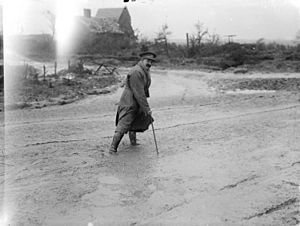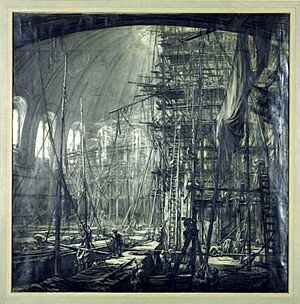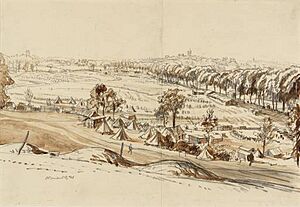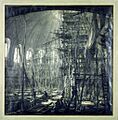Muirhead Bone facts for kids
Quick facts for kids
Sir Muirhead Bone
|
|
|---|---|

Bone during the Battle of the Somme, 1916
|
|
| Born | 23 March 1876 Glasgow, Scotland
|
| Died | 21 October 1953 (aged 77) Oxford, England
|
| Education | Glasgow School of Art |
| Known for | Painting, etching, drypoint, drawing |
| Spouse(s) | Gertrude Helena Dodd (m. 1903) |
Sir Muirhead Bone (born March 23, 1876 – died October 21, 1953) was a Scottish artist. He was famous for his etchings and watercolors. He often drew buildings and industrial scenes. He also became a special war artist in both World War I and World War II.
Bone was a very popular artist. His detailed drawings of buildings were highly valued. He was also a key member of committees. These committees helped support other artists. He served as a trustee for important art galleries. These included the Tate Gallery and the National Gallery. He also helped the Imperial War Museum.
Contents
Early Life and Art Beginnings

Muirhead Bone was born in Partick, Glasgow, Scotland. His father, David Drummond Bone, was a journalist. His mother was Elizabeth Millar Crawford.
Muirhead and his brothers went to a local school. They started apprenticeships at age fourteen. His older brother, James, became a newspaper reporter. Another older brother, David, joined the navy. He later became a ship commander. Muirhead first trained to paint porcelain. Then he became an architect's draughtsman. After four years, he decided to focus on art.
Bone studied art at the Glasgow School of Art. He took evening classes there. He became friends with artist Francis Dodd. He also met Francis's sister, Gertrude Helena Dodd. They got engaged in 1898. Bone started making prints in 1898. He is best known for his etchings and drypoints. He mostly drew landscapes and buildings. This included construction sites and old cathedrals.
In 1901, Bone moved to London. He met other famous artists there. He joined the New English Art Club. His first art show was in 1902. In 1903, Bone was successful enough to marry Gertrude. They moved to Chiswick. Their first son, Stephen, was born in 1904. Their second son, Gavin, was born in 1907.
War Artist in World War I
During World War I, Muirhead Bone became the first official British war artist. This happened in May 1916. He had worked hard to create this role. In June 1916, he went to France. He had an honorary rank and a salary. Bone was 38, so this job kept him from joining the army.
Bone's small, black and white drawings were very realistic. They looked great in government publications. He loved drawing complex scenes. This included huge ships in drydocks. He also drew thousands of shells in factories. His art always showed order and beauty.
Bone served with the Allied forces. He also worked with the Royal Navy. He arrived in France on August 16, 1916. This was during the Battle of the Somme. He made 150 war drawings. He returned to England in October 1916.
Over the next few months, Bone drew shipyards. These drawings were for a special war effort project. They were shown in Britain and other countries. Prints were sold to raise money for the war. He visited France again in 1917. There, he drew many ruined buildings. Two books of his war drawings were published. These were The Western Front and With the Grand Fleet. He also helped choose other artists for war commissions.
Between the World Wars
After World War I ended, Bone went back to his usual art. He helped promote other war artists. He traveled a lot to France, Italy, and the Netherlands. These trips influenced his art. In 1923, he drew the writer Joseph Conrad. This happened during a trip across the Atlantic Ocean.
In 1929, he visited Spain for a long time. This trip led to a book called Old Spain. His wife wrote the text for it. The book was published in 1936. During this time, he showed his art often. He became very famous in London and New York. Bone received a knighthood in 1937. This was for his great contributions to art. He served as a trustee for several art institutions. These included the Tate, the National Gallery, and the Imperial War Museum.
War Artist in World War II
When World War II began, Muirhead Bone joined the War Artists' Advisory Committee. He also became a full-time artist for the Ministry of Information. He specialized in drawing navy subjects. He drew coastal areas and evacuated troops. He also drew portraits of officers.
Sadly, his son Gavin passed away in 1943. After this, Bone decided not to continue his navy art commission. However, he remained an active committee member. His other son, Stephen Bone, took over the navy art position.
Later Life and Legacy
Bone passed away on October 21, 1953, in Oxford. He was buried in a churchyard in Whitegate, Cheshire. There is also a memorial stone for him in St. Paul's Cathedral in London.
Images for kids
-
Bone during the Battle of the Somme, 1916
-
The British Museum Reading Room, May 1907 (1907), Tate Gallery





